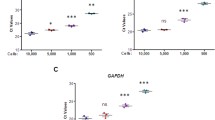Abstract
High-throughput microarray data are extensively produced to study the effects of different treatments on cells and their behaviours. Understanding this data and identifying patterns of groups of genes that behave differently or similarly under a set of experimental conditions is a major challenge. This has motivated researchers to consider multiple methods to identify patterns in the data and study the behaviour of hundreds of genes. This paper introduces three methods, one of which is a new technique and two are from the literature. The three methods are cluster mapping, Rank Products and SAM. Using real data from a number of microarray experiments comparing the effects of two very different products that can activate macrophage tumoricidal activity we have identified groups of genes that share interesting expression patterns. These methods have helped us to gain an insight into the biological problem under study.
Preview
Unable to display preview. Download preview PDF.
Similar content being viewed by others
References
Brazma, A., Vilo, J.: Gene expression data analysis. Federation of European BiochemicalSociety 480, 17–24 (2000)
Breitling, R., Armengaud, P., Amtmann, A., Herzyk, P.: Rank products: a simple, yet powerful, new method to detect differentially regulated genes in replicated microarray experiments. FEBS letters 573, 83–92 (2004)
Cleveland, W.S.: Robust locally weighted regression and smoothing scatter plots. J. Amer. Stat. Assoc. 74, 829–836 (1979)
Cui, X., Churchill, G.: Statistical tests for differential expression in cDNA microarray experiments. Genome Biology 4, 210 (2003)
Famili, A., Liu, Z., Ouyang, J., Walker, R., Smith, B., O’Connor, M., Lenferink, A.: A novel data mining technique for gene identification in time-series gene expression data. In: ECAI Workshop on Data Mining in Genomics and Proteomics, pp. 25–34 (2003)
Getz, G., Levine, E., Domany, E.: Coupled two-way clustering analysis of gene microarray data. PNAS 97(22), 12079–12084 (2000)
Li, T., Zhang, C., Ogihara, M.: A comparative study of feature selection and multi-class classification methods for tissue classification based on gene expression. Journal of Bioinformatics 20(15), 2429–2437 (2004)
Tang, C., Li, Z., Zhang, A., Ramanathan, M.: Interrelated two-way clustering: an unsupervised approach for gene expression data analysis. In: Proceedings of the 2nd International Symposium on Bioinformatics and Biocomputing, pp. 41–48 (2001)
Troyanskaya, O.G., Garber, M.E., Brown, P.O.: Nonparametric methods for identifying differentially expressed genes in microarray data. Journal of Bioinformatics 18(11), 1454–1461 (2002)
Tsai, C.-A., Chen, Y.-J., Chen, J.: Testing for differentially expressed genes with microarray data. Journal of Nucleic Acids Research 31(9), 52 (2003)
Tusher, V.G., Tibshirani, R., Chu, G.: Significance analysis of microarrays applied to the ionizing radiation response. PNAS 98(9), 5116–5121 (2001)
Wolpert, D.H.: Stacked Generalization. In: Neural Networks, vol. 5, pp. 241–259. Pergamon Press, Oxford (1992)
Author information
Authors and Affiliations
Editor information
Editors and Affiliations
Rights and permissions
Copyright information
© 2005 Springer-Verlag Berlin Heidelberg
About this paper
Cite this paper
Famili, A.F., Liu, Z., Carmona-Saez, P., Mullick, A. (2005). Knowledge Discovery in the Identification of Differentially Expressed Genes in Tumoricidal Macrophage. In: Famili, A.F., Kok, J.N., Peña, J.M., Siebes, A., Feelders, A. (eds) Advances in Intelligent Data Analysis VI. IDA 2005. Lecture Notes in Computer Science, vol 3646. Springer, Berlin, Heidelberg. https://doi.org/10.1007/11552253_8
Download citation
DOI: https://doi.org/10.1007/11552253_8
Publisher Name: Springer, Berlin, Heidelberg
Print ISBN: 978-3-540-28795-7
Online ISBN: 978-3-540-31926-9
eBook Packages: Computer ScienceComputer Science (R0)




